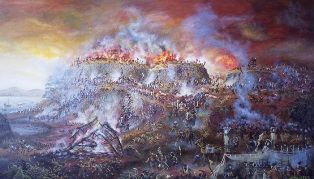 Source: pine-o.co.jp. The fall of Hara castle, 1638.
Source: pine-o.co.jp. The fall of Hara castle, 1638. 島原の乱 The Shimabara Rebellion
At the outset of the Edo period, the area of Kyushu known as the Shimabara peninsula (located in modern Nagasaki prefecture), and the area known as Amakusa Island (located in modern Kumamoto prefecture) had witnessed a steady growth in Christian followers over the years. However the lord of Shimabara province, Matsukura Katsuie, and his counterpart in Karazu province (which housed the Amakusa island chain), Terazawa Katataka, had both earned the ire of local residents through their imposition of excessive taxation and suppression of local Christian beliefs. Add to this the fact that in the mid 1630s the region had experienced a series of bad harvests, and soon apocalyptic teachings and messages of the second coming of Christ began to resonate very loudly among the local peasant population. In the 10th month of Kanei 14 (1637), things came to a head with the outbreak of a rebellion among locals on the southern tip of Shimabara peninsula.(p.198)
The rebellion soon spread to cover virtually the entire peninsula, and culminated in an attack by local groups on the local castle at Shimabara itself. Moreover, peasants on the island of Amakusa also rose in revolt against the Terazawa, and joining forces with groups from Shimabara surrounded the main Terazawa castle at Tomioka (located in modern Reihoku town in Kumamoto prefecture) and brought it to the brink of surrender. The leaders of this rebellion were drawn from among the disaffected samurai (or ronin) that lived in the region, together with a section of the leaders of local communities. While providing military leadership to the group, they also used the Christian religion to keep the group together. On the island of Oyano, one of the islands in the Amakusa island chain, a `saviour` figure emerged in the form of one Amakusa Shiro (also known as Mashita Shiro Tokitada). (p.198)
An army of 120,000 to suppress a rebellion
The Tokugawa Bakufu was particularly concerned by this outbreak of rebellion, and ordered Itakura Shigemasa to lead a force draw together from resources from Saga, Yanagawa, and Kurume provinces against the rebellious locals. In the 12th month of the same year, a force of around 20,000 men and women, young and old, retreated to the old castle at Hara (in modern Minami-Arima town in Nagasaki prefecture) and there prepared themselves for a siege. The involvement of the religious factor of Christianity would from here on influence official thinking on all forms of peasant rebellion, and thus Christianity would be associated with disorder and rebellion.(p.198)
In the 1st month of the following year (1638), Itakura Shigemasa died while fighting against the local rebels. His replacement, Matsudaira Nobutsuna, a senior retainer in the Bakufu (his name demonstrates that he was a direct relative of the Shōgun himself) was given command of a (for the time) huge army of 120,000 soldiers who were dispatched to Kyushu. Upon arrival at Hara, Matsudaira began his siege of the castle, adopting a strategy of cutting off the castle`s supply lines. The Bakufu had also managed to secure assistance from visiting Dutch trading ships in the area who used their ships` cannon against the old castle. (198)
While the defenders of the castle were still resolute in their determination to resist the Bakufu, on the 27th of the 2nd month the castle`s food supplies ran out. On the following day, the Bakufu forces launched an all-out attack against the castle, whereby they overwhelmed the weakened defenders therein and slaughtered every one of them. (p.198)
The total casualties among the Bakufu forces were calculated at some 12,000, which indicates the degree of ferocity by which the local rebels defended the castle (and may also indicate the degree to which disease may have swept through the Bakufu camp while engaged in the siege). After the castle fell, the Bakufu decided to punish both Matsukura Katsuie and Terazawa Katataka by seizing their territory, and executing Katsuie. Katataka, perhaps knowing that he would met a similar fate, instead chose ritual suicide. The Bakufu, in order to ensure that no peasant rebellion might ever again threaten its rule, imposed a range of strict measures on peasant communities, and banned the practice of Christianity among the peasantry. It also banned Portuguese traders from the country, and forbade any Japanese from trading with Portugal. This would lead to the phenomenon of self-imposed isolation by Japan from the outside world (other known as Sakoku, or 鎖国), a practice that in turn solidified and strengthened the Bakufu`s hold over the country. (p.198)
 RSS Feed
RSS Feed